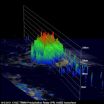(Press-News.org) Tropical Storm Philippe took its time to strengthen into a hurricane because of wind shear problems. The wind shear lessened, and Philippe became a hurricane today, after 12 days of moving across the Atlantic Ocean. NASA's TRMM satellite saw towering thunderstorms and intense rainfall within Philippe yesterday, which provided forecasters with a clue that the storm was strengthening. Philippe reached hurricane status this morning, Oct. 6, 2011.
Over two days, the Tropical Rainfall Measuring Mission (TRMM) satellite provided forecasters with cloud heights and rainfall rates occurring within Tropical Storm Philippe. TRMM is managed by both NASA and the Japanese Space Agency, JAXA.
The National Hurricane Center (NHC) upgraded Philippe to a hurricane at 1500 UTC (11 a.m. EDT) on Thursday, October 6 2011. Earlier TRMM Microwave Imager (TMI) data from October 6, 2011 at 0024 UTC (Oct. 5 at 8:24 p.m. EDT) showed that tropical storm Philippe's center of circulation had become better defined and an eyewall was forming. Microwave satellite imagery also shows an eye-like feature, while the visible imagery from NOAA's GOES satellite hints at the indication of an eye, although mostly covered with clouds.
On Oct. 6, Philippe's maximum sustained winds were near 80 mph (130 kmh). Philippe is a Category One hurricane on the Saffir-Simpson scale, but some weakening is forecast in the next two days. Philippe is located about 425 miles (680 km) southeast of Bermuda, near 27.8 North and 60.0 West. The hurricane is moving to the north-northeast near 9 mph (15 kmh) and is expected to move toward the northeast and speed up.
The TRMM satellite also had an excellent look at Philippe earlier on Wednesday, October 5, 2011 at 1752 UTC (1:52 p.m. EDT). TRMM's Precipitation Radar (PR) scanned directly over Philippe and revealed that Philippe had bands of intense rainfall that around the southeast side of the center of circulation.
A 3-D rendering of that TRMM PR data showed deep convective towers reached to heights of over 13km (~8 miles). Previous research from NASA scientists show that whenever these "hot towers" are spotted within a tropical cyclone, the storm typically intensifies within six hours, and Philippe became a hurricane today.
INFORMATION:
NASA's Hurricane page is found at http://www.nasa.gov/hurricane; and is available on Facebook and Twitter: NASAHurricane
A 3-D look at Philippe provided clues of transition into a hurricane
2011-10-10
ELSE PRESS RELEASES FROM THIS DATE:
Astrophysicists spot pulsed radiation from Crab Nebula that wasn't supposed to be there
2011-10-10
An international collaboration of astrophysicists, including a group from the Department of Physics in Arts & Sciences at Washington University in St. Louis, has detected pulsed gamma rays from the neutron star at the heart of the Crab Nebula with energies far higher than the common theoretical models can explain.
The pulsed gamma rays had energies between 100 and 400 billion electronvolts (Gigaelectronvolts, or GeV), far higher than 25 GeV, the highest energy radiation from the neubla previously detected. A 400 GeV photon is 11 orders of magnitude – almost a trillion ...
Crab Pulsar emits light at highest energies ever detected in a pulsar system, scientists report
2011-10-10
An international team of scientists has detected the highest energy gamma rays ever observed from a pulsar, a highly magnetized and rapidly spinning neutron star.
The VERITAS experiment measured gamma rays coming from the Crab Pulsar at such large energies that they cannot be explained by current scientific models of how pulsars behave, the researchers said.
The results, published today in the journal Science, outline the first observation of photons from a pulsar system with energies greater than 100 billion electron volts -- more than 50 billion times higher than ...
Sniffing out the brain's predictive power
2011-10-10
CHICAGO --- In the moments before you "stop and smell the roses," it's likely your brain is already preparing your sensory system for that familiar floral smell. New research from Northwestern Medicine offers strong evidence that the brain uses predictive coding to generate "predictive templates" of specific smells -- setting up a mental expectation of a scent before it hits your nostrils.
Predictive coding is important because it provides animals -- in this case, humans -- with a behavioral advantage, in that they can react more quickly and more accurately to stimuli ...
Study uncovers why anti-rejection drugs for transplant patients cause hypertension
2011-10-10
PORTLAND, Ore. — Modern medicine's ability to save lives through organ transplantation has been revolutionized by the development of drugs that prevent the human body from rejecting the transplanted organ.
But those antirejection drugs have their own side effects — sometimes serious.
A group of researchers led by scientists at Oregon Health & Science University has discovered the process that may be causing many of those side effects. And the discovery means those side effects likely can be dealt with cheaply and easily — with a class of widely used drugs that are often ...
Bone marrow cells migrate to tumors and can slow their growth
2011-10-10
Philadelphia, PA, October 6, 2011 – Bone marrow-derived cells (BMDCs) participate in the growth and spread of tumors of the breast, brain, lung, and stomach. To examine the role of BMDCs, researchers developed a mouse model that could be used to track the migration of these cells while tumors formed and expanded. Their results, published in the November issue of The American Journal of Pathology, strongly suggest that more effective cancer treatments may be developed by exploiting the mechanism by which bone marrow cells migrate to tumors and retard their proliferation.
"Our ...
Raising 'good' cholesterol levels reduces heart attack and stroke risk in diabetes patients
2011-10-10
Increasing levels of high-density lipoproteins, better known as HDL or "good" cholesterol, reduced the risk for heart attack and stroke among patients with diabetes. That's according to a new study appearing online today in The American Journal of Cardiology.
The observational study, one of the largest of its kind, examined the medical records of more than 30,000 patients with diabetes and also found that patients whose HDL levels decreased had more heart attacks and strokes.
Researchers studied patients with diabetes because they are more prone to heart disease ...
'Non-invasive' cultivar? Buyer beware
2011-10-10
Cultivars of popular ornamental woody plants that are being sold in the United States as non-invasive are probably anything but, according to an analysis by botanical researchers published in the October issue of BioScience. Tiffany M. Knight of Washington University in St. Louis, Missouri, and her coauthors at the Chicago Botanic Garden write that the claims of environmental safety are in most cases based on misleading demographic evidence that greatly underestimates the plants' invasive potential. What is more, the offspring of cultivars do not usually "breed true" and ...
Strategy for improving health care for uninsured, low-income, and minorities in the US
2011-10-10
New York, NY, October 7, 2011—A new set of strategies released today by the Commonwealth Fund Commission on a High Performance Health System could dramatically improve how the U.S. health care system serves vulnerable populations—those in the U.S. who are uninsured, low-income, or members of racial and ethnic minority groups.
According to the new report, Ensuring Equity: A Post-Reform Framework to Achieve High Performance Health Care for Vulnerable Populations, closing the health care divide will require a three-pronged policy framework that ensures adequate access to ...
University of Tennessee scientist searches for moons around asteroids
2011-10-10
Most people know that some planets have moons but would be surprised to know that some asteroids do, too. According to Joshua Emery, assistant professor of earth and planetary sciences at the University of Tennessee, Knoxville, about 20 percent of them do.
Emery is part of an international team of planetary astronomers, led by Franck Marchis of the Carl Sagan Center of the SETI Institute in Mountain View, Calif., searching for moons around asteroids. The discovery of moons around asteroids is important because it can provide clues to the asteroid's formation.
Emery ...
Astrophysics and extinctions: News about planet-threatening events
2011-10-10
Boulder, CO, USA - Space is a violent place. If a star explodes or black holes collide anywhere in our part of the Milky Way, they'd give off colossal blasts of lethal gamma-rays, X-rays and cosmic rays and it's perfectly reasonable to expect Earth to be bathed in them. A new study of such events has yielded some new information about the potential effects of what are called "short-hard" interstellar radiation events.
Several studies in the past have demonstrated how longer high-energy radiation bursts, such as those caused by supernovae, and extreme solar flares can ...


